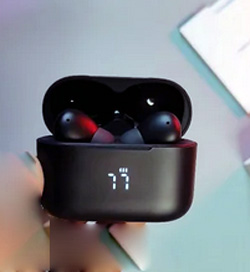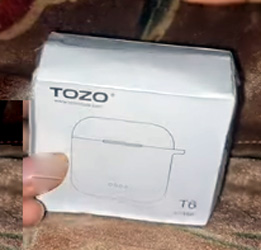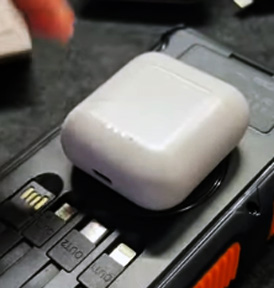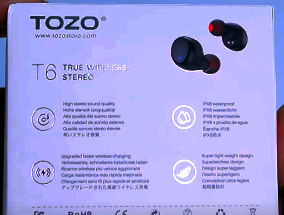I’ve spent countless hours testing wireless earbuds, chasing that perfect blend of sound, comfort, and value. The TOZO T6 and T20 caught my attention for their affordability and feature-packed designs, but which one truly delivers? In this article, I’ll share my hands-on experience comparing these two popular TOZO models, breaking down their pros and cons to help you decide which fits your lifestyle. From sound quality to battery life, I’ve got you covered with a detailed, honest take to guide your choice.
Comparison Table: TOZO T6 Vs. T20 At A Glance
| Feature | TOZO T6 | TOZO T20 |
| Bluetooth Version | 5.3 | 5.3 |
| Driver Size | 6mm | 10mm |
| Battery Life (Earbuds) | 10 hours | 12 hours |
| Total Battery Life (with Case) | 45 hours | 48.5 hours |
| Waterproof Rating | IPX8 | IPX8 |
| Charging Port | Micro USB | USB-C |
| Charging Case Size | Compact, protective flap | Larger, with lanyard hook |
| Noise Cancellation | Passive | Dual-mic ENC |
| EQ Customization | 32 preset EQs via TOZO app | Multiple EQ options via TOZO app |
| Touch Controls | Yes, sensitive | Yes, with stem design |
| Weight (per Earbud) | ~4.5g | ~5g |
| Price (Approximate) | $20–$30 | $30–$40 |
My Journey With TOZO Earbuds
Also Read: My Thought on Sentdream Ai Headphones Review

I’m no audiophile, but I know what I want from earbuds: crisp sound, a snug fit, and a battery that doesn’t quit mid-run. TOZO’s T6 and T20 have been on my radar because they promise premium features without breaking the bank. I’ve used both for workouts, commutes, and lazy days binge-listening to podcasts, so this comparison comes from real-world use. Let’s break it down by key features to see how they stack up and where they shine—or fall short.
Design And Comfort: Finding The Perfect Fit
TOZO T6: Sleek And Discreet
The T6 earbuds are small and lightweight, clocking in at about 4.5 grams each. They slip into my ears effortlessly, and with multiple ear tip sizes included, I found a fit that feels secure without being intrusive. The in-ear design creates a solid seal, which helps with passive noise isolation—perfect for blocking out gym chatter or street noise. The charging case is a standout: compact, with a protective flap over the micro USB port, it’s easy to toss in a pocket. I love the color options too—Champagne and Rose Gold add a touch of flair.
Pros:
- Super compact and lightweight for all-day wear.
- Multiple ear tip sizes ensure a snug, personalized fit.
- Stylish color options make them a bit of a fashion statement.
- Compact case with a protective flap is pocket-friendly.
Cons:
- Micro USB port feels dated compared to USB-C.
- Touch controls can be overly sensitive, leading to accidental taps.
TOZO T20: Modern with a Stem

The T20 takes a different approach with a stem design, reminiscent of AirPods. At about 5 grams per earbud, they’re slightly heavier, but the curved in-ear shape keeps them secure during runs or workouts. The stem makes them easier to adjust without triggering touch controls, which I found less finicky than the T6. The charging case is larger, with a USB-C port and an optional lanyard hook—a nice touch for portability. The T20’s modern aesthetic feels a bit more premium, but the larger case isn’t as pocket-friendly.
Pros:
- Stem design improves handling and control precision.
- USB-C charging is faster and more convenient.
- Secure fit with six ear tip sizes for customization.
- Lanyard hook on the case adds portability.
Cons:
- Slightly heavier, which may cause fatigue during long sessions.
- Larger case is less discreet in small pockets.
My Take On Design
The T6 wins for portability and discreetness, perfect if you want earbuds that practically disappear in your ears and pocket. The T20, with its stem and larger case, feels more robust but sacrifices some of that sleekness. For workouts, both stay put, but the T20’s stem makes on-the-fly adjustments easier. If you prioritize a minimalist vibe, go T6; if you want a modern look with better handling, the T20’s your pick.
Sound Quality: Bass, Clarity, And Immersion
TOZO T6: Punchy but Compact
The T6’s 6mm dynamic drivers deliver a surprisingly punchy sound for their size. I noticed a warm, bass-heavy profile that makes hip-hop and EDM tracks pop. The mids are clear, especially for vocals, but there’s a slight congestion in the lower midrange, which can muddy complex tracks like jazz or classical. The treble is crisp without being harsh, though it lacks the sparkle you’d get from pricier earbuds. The TOZO app’s 32 preset EQs let me tweak the sound to my liking, which is a huge plus for a budget pair.
Pros:
- Strong, punchy bass ideal for bass-heavy genres.
- 32 EQ presets via the TOZO app for customization.
- Clear mids and balanced treble for versatile listening.
- Effective passive noise isolation enhances immersion.
Cons:
- Small 6mm drivers limit soundstage depth.
- Midrange can feel congested in complex tracks.
TOZO T20: Bigger Drivers, Bigger Sound

With 10mm drivers, the T20 steps up the audio game. The bass is deeper and more robust, giving tracks a fuller, more immersive feel. I found the soundstage wider, making it easier to pick out instruments in rock or orchestral music. The mids are slightly clearer than the T6, and the treble has a bit more detail, though it can edge toward sibilance at higher volumes. The T20 also supports EQ customization via the TOZO app, though with fewer presets than the T6. The dual-mic environmental noise cancellation (ENC) makes calls clearer in noisy settings, a feature the T6 lacks.
Pros:
- 10mm drivers deliver richer bass and a wider soundstage.
- Clearer mids and detailed treble for a more immersive experience.
- Dual-mic ENC improves call quality in noisy environments.
- EQ customization via the TOZO app for tailored sound.
Cons:
- Treble can get sharp at high volumes.
- Fewer EQ presets compared to the T6.
My Take On Sound
The T20’s larger drivers give it an edge for music lovers who crave depth and immersion. It’s my go-to for genres that demand a wide soundstage, like rock or electronic. The T6 holds its own with punchy bass and is great for casual listening or podcasts, but it can’t match the T20’s fullness. If call quality matters, the T20’s ENC is a game-changer. Both benefit from the TOZO app’s EQ settings, but the T20 feels like the more refined audio experience.
Battery Life And Charging: Staying Powered Up
TOZO T6: Long-Lasting but Dated Charging
The T6 offers 10 hours of playtime per charge, with the case providing an additional 35 hours, totaling 45 hours. In my tests, I got close to 9.5 hours per charge with moderate volume, which is impressive for the price. The case’s LED lights clearly show battery levels, but the micro USB port feels like a step back in 2025. Charging takes about 2 hours, and wireless charging is a nice touch, though I found myself sticking to wired charging for speed.
Pros:
- 10 hours per charge with a total of 45 hours.
- Wireless charging support for convenience.
- Clear LED battery indicators on the case.
Cons:
Micro USB port is slower and less modern.
- Wired charging takes longer than USB-C.
TOZO T20: Extended Playtime, Modern Charging
The T20 edges out with 12 hours per charge and a total of 48.5 hours with the case. I consistently hit 11 hours during mixed use (music, calls, and podcasts), which kept me going through long days. The USB-C port charges faster—about 1.5 hours for a full charge—and the LED digital display on the case is more precise than the T6’s lights. Wireless charging is also supported, making the T20 feel more future-proof.
Pros:
- 12 hours per charge with a total of 48.5 hours.
- Faster USB-C charging.
- Precise LED digital display for battery levels.
- Wireless charging support.
Cons:
- Larger case takes up more space.
- Slightly heavier earbuds may drain battery faster during intense use.
My Take On Battery Life
The T20’s longer playtime and USB-C charging make it the winner for those who need earbuds that last and recharge quickly. The T6’s battery life is still excellent, but the micro USB port feels outdated. If you’re always on the go and hate fumbling with old cables, the T20’s modern charging setup is a clear advantage. Both support wireless charging, which is a nice perk at this price.
Connectivity And Controls: Seamless Or Frustrating?
Also Read: My Thought on Sentdream Ai Headphones Review
TOZO T6: Reliable but Touchy
The T6 uses Bluetooth 5.3 for a stable connection, and I rarely experienced dropouts, even in crowded areas. Pairing is quick, though it lacks advanced features like Google Fast Pair. The touch controls are intuitive for play/pause, track skipping, and volume, but they’re overly sensitive. I accidentally paused music while adjusting the earbuds more times than I’d like. Latency is decent (167ms on iOS, 280ms on Android), making them fine for casual video watching but not ideal for gaming.
Pros:
- Stable Bluetooth 5.3 connection.
- Quick and easy pairing process.
- Touch controls cover all essential functions.
Cons:
- Overly sensitive touch controls lead to accidental inputs.
- Higher latency on Android devices.
TOZO T20: Smoother and More Reliable
The T20 also uses Bluetooth 5.3, and I found its connection slightly more robust, especially at longer ranges (up to 15 meters in open spaces). The stem design makes touch controls less prone to accidental taps, and I appreciated the tactile feedback. The T20 supports dual-mic ENC, which significantly improves call clarity in noisy environments like cafes or busy streets. Latency is slightly better than the T6, but still not gamer-friendly.
Pros:
- Robust Bluetooth 5.3 with improved range.
- Stem design reduces accidental touch inputs.
- Dual-mic ENC enhances call quality.
Cons:
- Latency still noticeable for gaming.
- Slightly bulkier design may affect portability.
My Take on Connectivity
Both earbuds offer reliable Bluetooth 5.3, but the T20’s stem design and ENC make it better for calls and active use. The T6’s sensitive touch controls were a minor annoyance, especially during workouts. If you take a lot of calls or need a rock-solid connection, the T20 pulls ahead. For casual use, the T6 is more than sufficient.
Durability And Waterproofing: Built For The Long Haul?

TOZO T6: Tough and Weather-Proof
The T6’s IPX8 rating means it can handle sweat, rain, and even submersion, making it ideal for workouts or outdoor adventures. I’ve worn them during intense runs and in light rain with no issues. The charging case’s protective flap adds extra peace of mind, keeping the port safe from dust and water. However, the plastic flap feels flimsy and could wear out over time.
Pros:
- IPX8 rating ensures durability in wet conditions.
- Protective flap on the charging case adds security.
- Compact design feels sturdy for daily use.
Cons:
- Flimsy flap on the charging case may break over time.
- Micro USB port less durable than USB-C.
TOZO T20: Equally Rugged, Modern Build
The T20 also boasts an IPX8 rating, and I’ve tested it in similar conditions—sweaty workouts and rainy walks—with no problems. The larger case feels more robust, and the USB-C port is a more durable choice for long-term use. The lanyard hook is a thoughtful addition for those who might drop or misplace the case. However, the larger size makes it less discreet.
Pros:
- IPX8 rating for worry-free use in tough conditions.
- Sturdy USB-C port for long-term durability.
- Lanyard hook enhances portability and security.
Cons:
- Larger case is less pocket-friendly.
- Slightly heavier earbuds may feel less durable during rough use.
My Take on Durability
Both earbuds are built to withstand active lifestyles, with IPX8 ratings that inspire confidence. The T20’s USB-C port and lanyard hook give it a slight edge for longevity and convenience, but the T6’s compact case is easier to carry. If you’re rough on gear, either will hold up, but the T20 feels a bit more future-proof.
Price And Value: Bang For Your Buck
TOZO T6: Budget Champion
Priced between $20–$30, the T6 is a steal for its feature set. You get Bluetooth 5.3, IPX8 waterproofing, solid battery life, and app-based EQ customization at a price that undercuts most competitors. It’s perfect for budget-conscious buyers who want reliable performance without bells and whistles.
Pros:
- Extremely affordable for the features.
- Great value for casual listeners and fitness enthusiasts.
- App support adds customization at a low price.
Cons:
- Lacks advanced features like ENC or multipoint pairing.
- Micro USB feels like a cost-cutting measure.
TOZO T20: Premium Features, Modest Price
At $30–$40, the T20 is slightly pricier but justifies the cost with larger drivers, ENC, and USB-C charging. It’s still a budget-friendly option compared to brands like JBL or Sony, offering near-premium performance for a fraction of the cost. The extra features make it feel like a step up.
Pros:
- Excellent value for enhanced sound and features.
- USB-C and ENC add premium touches.
- Competitive pricing against bigger brands.
Cons:
- Slightly higher price may not suit the tightest budgets.
- Larger case sacrifices some portability.
My Take On Value
The T6 is the king of budget earbuds, delivering core features at a rock-bottom price. The T20, while more expensive, offers enough upgrades—better sound, ENC, and faster charging—to justify the cost for most users. If you’re pinching pennies, the T6 is a no-brainer; if you can stretch your budget, the T20’s enhancements are worth it.
Real-World Use: How They Fit My Life
I tested both earbuds in various scenarios: gym sessions, long commutes, and work-from-home calls. The T6’s compact size made it my go-to for quick workouts or casual listening. Its lightweight design and secure fit never let me down, though the sensitive touch controls occasionally frustrated me. The T20, with its richer sound and clearer calls, was better for longer listening sessions or when I needed to hop on a call in a noisy coffee shop. The stem design made adjustments easier, but the larger case was a bit cumbersome in tight pockets.
For running, both stayed secure, but the T20’s ENC gave it an edge for calls on windy days. For music, the T20’s deeper bass and wider soundstage made my playlists more engaging, while the T6 was perfectly fine for podcasts or less demanding tracks. Battery life rarely left me stranded, though the T20’s extra hours were noticeable on long trips.
Who Should Buy Which?
Choose the TOZO T6 If:
- You’re on a tight budget and want reliable earbuds.
- You prefer a compact, discreet design.
- You mostly listen to podcasts or bass-heavy music.
- You don’t mind micro USB charging.
Choose the TOZO T20 If:
- You want richer sound with deeper bass and a wider soundstage.
- You take frequent calls in noisy environments.
- You prefer modern features like USB-C and ENC.
- You’re okay with a slightly larger case for added durability.
Frequently Asked Questions (Faq)
TOZO offers better value for budget-conscious buyers, with solid sound and features at a lower price. JBL has superior sound quality and brand reliability but is much pricier.
Sony excels in premium sound and advanced features like ANC, but TOZO’s affordability and solid performance make it a better choice for budget users.
Yes, the T6 is excellent for its price, offering strong bass, IPX8 waterproofing, and long battery life, ideal for casual use and workouts.
Soundcore often includes ANC and slightly better sound, but TOZO’s lower price and similar features make it a strong contender for value-driven buyers.
Conclusion: Your Perfect Pair Awaits
Also Read: My Thought on Sentdream Ai Headphones Review
After testing the TOZO T6 and T20, I can confidently say both are fantastic for the price, but your choice depends on what you value most. The T6 is your best bet if you want a compact, budget-friendly pair that punches above its weight. The T20, with its richer sound, modern charging, and call-friendly features, is worth the extra bucks if you crave a more premium experience. Whichever you pick, TOZO delivers quality that makes you question why you’d spend more. So, what’s your priority—saving cash or stepping up your audio game?
